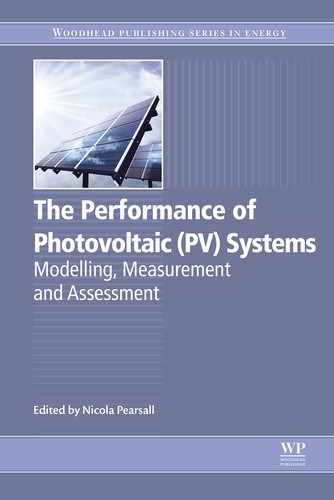Preface
Photovoltaic (PV) systems, converting incident solar energy directly into electricity, are an elegant and versatile way of harnessing renewable energy and have a major part to play in the transition in our energy systems required by the issues of climate change, reducing fossil fuel resources and energy security. Over the last decade, the installed capacity has grown rapidly and, at the time of writing, stands at over 300 GW worldwide. This is still a small percentage of the overall installed capacity of electricity generation, but PV is becoming a mainstream technology as the costs continue to decline. However, in order to ensure the maximum contribution from PV, we must not only install the systems but operate them in an efficient manner across their lifetime. This requires a consistent approach to determining the performance and quality of the components and the systems, a clear understanding of the loss mechanisms and how to minimize them and the long-term measurement and analysis of field performance to ensure maximum output.
Most previous books on photovoltaic technology have concentrated on the theory and design of the photovoltaic cells or systems. In contrast, this book focusses on how to measure and assess the performance of the components of the PV systems and on how to define and address the performance of the PV system in the field. The book is split into three main parts, following an introductory chapter that aims to provide an overview of PV systems and their performance as both a primer for the inexperienced reader and a reminder for those already familiar with the technology. Part One deals with the performance of the PV module, which performs the actual conversion process. Topics covered by the chapters in this part include measurement of the module rating, prediction of energy yield and changes to module performance in operation. Part Two considers the performance of the PV system, now including chapters on balance of system components, prediction and monitoring of PV system output and the environmental assessment of the systems. Finally, Part Three considers individual system types, including grid-connected and stand-alone system configurations, concentrator systems and specific performance aspects relating to building integration. This part addresses the performance issues relating to these different applications from the general viewpoint of maximizing performance in each case.
The individual chapters have been authored by experts in their field, representing several of the major research organizations in photovoltaics in Europe and the United States of America. In each case, the authors have drawn on their research expertise to provide a state-of-the-art treatment of their topic. Nevertheless, the field of photovoltaic technology is advancing rapidly, so each chapter also includes some consideration of the likely future developments in that subject area.
Because of the wide range of applications of photovoltaics and the rapid progress being made, it is impossible to cover all the aspects of PV performance in a single volume of reasonable size. However, the rationale behind this book is to focus clearly on component and system performance so as to provide a detailed introduction to the issues and to encourage the assessment of performance at all stages of the development, design and operation of PV systems.
July 2016
